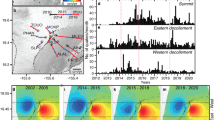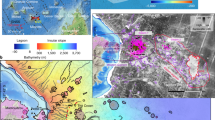Abstract
On 30 January 1997 an intrusion on Kīlauea volcano opened a new fissure within the East Rift Zone (ERZ) at Nāpau Crater, 3 km uprift from the ongoing eruptions at Pu’u ’Ō’ō. The fissure eruption lasted 22 h and opened a 5.1 km long, nearly vertical dike 1.9 m, extending from the surface to a depth of 2.4 km (Owen et al. 2000b). During the eruption, the lava pond at Pu’u ’Ō’ō drained, and eruptions ceased there. Pu’u ’Ō’ō eventually refilled in late February and eruptions resumed there on 28 March 1997. Continuous GPS data show a large transient following the 30 January 1997 dike intrusion. After lengthening 40 cm during the initial eruption, the baseline between two stations spanning the ERZ lengthened an additional 10 cm over the following 6 months. A coastal station KAEP also exhibited transient deformation, as it continued to move southward (5 cm) over the same 6-month period. The baseline between two stations spanning Kīlauea’s summit caldera contracted sharply during the eruption, but gradually recovered to slightly longer than its previous length 2 months after the intrusion. We use the extended network inversion filter (McGuire and Segall 2003) to invert continuous GPS data for volume change of a spherical pressure source under Kīlauea’s summit, opening distribution on a nearly vertical dike in the ERZ and potential slip on a decollement 9 km beneath the south flank. Following the 30 January intrusion, rift extension continued below the initial dike intrusion for the duration of the transient. Decollement slip, regardless of its assumed depth, is not required to fit the data. The modeled transient summit reinflation and rift opening patterns under Nāpau crater coincide with changes in observed behavior of Pu’u ’Ō’ō’s lava pond. Rift opening accelerated while Pu’u ’Ō’ō eruptions paused and began to decelerate after the lava pond reappeared nearly a month after the Nāpau eruption. The transient deformation is interpreted as resulting from shallow accommodation of the new dike volume.












Similar content being viewed by others
References
Amelung F, Jónsson S, Zebker H, Segall P (2000) Widespread uplift and ‘trapdoor’ faulting on Galapagos volcanoes observed with radar interferometry. Nature 407(6807):993–996
Ando M (1979) The Hawaii earthquake of November 1979: low dip angle faulting due to forceful injectino of magma. J Geophys Res 84:7616–7626
Árnadóttir T, Segall P, Matthews M (1991) A fault model for the 1989 Kilauea south flank earthquake from level and seismic data. Geophys Res Lett 18(12):2217–2220
Bjórnsson A, Sæmundsson K, Einarsson P, Tryggvason E, Gronvold K (1977) Current rifting episode in north Iceland. Nature 266(5600):318–323
Bjórnsson A, Johnsen G, Sigurdsson S, Thorbergsson G, Tryggvason E (1979) Rifting of the plate boundary in north Iceland 1975–1978. J Geophys Res 84(NB6):3029–3038
Bonaccorso A, Davis P (1993) Dislocation modelling of the 1989 dike intrusion into the flank of Mount Etna, Sicily. J Geophys Res 98(B3):4261–4268
Bonaccorso A, Aloisi M, Mattia M (2002) Dike emplacement forerunning the Etna July 2001 eruption modeled through continuous tilt and GPS data. Geophys Res Lett 29(13):1–2
Cervelli P, Segall P, Amelung F, Garbeil H, Meertens C, Owen S, Miklius A, Lisowski M (2002a) The 12 September 1999 Upper East Rift Zone dike intrusion at Kilauea Volcano, Hawaii: art. no. 2150. J Geophys Res 107(B7):2150
Cervelli P, Segall P, Johnson K, Lisowski M, Miklius A (2002b) Sudden aseismic fault slip on the south flank of Kilauea volcano. Nature 415(6875):1014–1018
Creutz M (1984) Monte-carlo study of quantized su(2) gauge theory. Phys Rev D 21:2308–2315
Delaney P, Denlinger R, Lisowski M, Miklius A, Okubo P, Okamura A, Sako M (1998) Volcanic spreading at Kilauea, 1976–1996. J Geophys Res 103(B8):18003–18023
Desmarais E, Segall P, M A (2005) A series of transient slip events on Kilauea volcano, Hawaii. EOS Trans AGU Fall Meet Suppl 85(47) G533B–G878B, Abstract
Dieterich J (1988) Growth and persistence of Hawaiian volcanic rift zones. J Geophys Res 93(B5):4258–4270
Du Y, Aydin A (1992) 3-Dimensional characteristics of dike intrusion along the northern Iceland rift from inversion of geodetic data. Tectonophysics 204(1–2):111–121
Dvorak JJ, Dzurisin D (1997) Volcano geodesy: the search for magma reservoirs and the formation of eruptive vents. Rev Geophys 35(3):343–384
Foulger G, Jahn C, Seeber G, Einarsson P, Julian B, Heki K (1992) Post-rifting stress relaxation at the divergent plate boundary in northeast Iceland. Nature 358(6386):488–490
Got J, Frechet J, Klein F (1994) Deep fault plane geometry inferred from multiplet relative relocation beneath the south flank of Kilauea. J Geophys Res 99(B8):15375–15386
Got J-L, Okubo P (2003) New insights into Kilauea’s volcano dynamics brought by large scale relative relocation of microearthquakes. J Geophys Res 108(B7):2337–2350
Gregorius T (1996) GIPSY-OASIS II: how it works. Univ. of Newcastle upon Tyne, New Castle, England, UK, (self-published)
Heliker C, Sherrod D, Thornber C, Kauahikaua J (1997) Kilauea Volcano East Rift Zone eruptions update: 1997 brings era of instability. EOS Trans AGU Fall Meet Suppl 78:T21A–T28A
Hooper A, Segall P, Johnson K, Rubinstein J (2002) Reconciling seismic and geodetic models of the 1989 Kilauea south flank earthquake. Geophys Res Lett 29(22):2062–2066
Jónsson S, Zebker K, Cervelli P, Segall P, Garbeil H, Mouginis-Mark P, Rowland S (1999) A shallow-dipping dike fed the 1995 flank eruption at Fernandina volcano, Galapagos, observed by satellite radar interferometry. Geophys Res Lett 26(8):1077–1080
King G, Stein R, Lin J (1994) Static stress changes and the triggering of earthquakes. Bull Seismol Soc Am 84:935–953
Klein F (1981) A linear gradient crustal model for south Hawaii. Bull Seismol Soc Am 71(5):1503–1510
Klein F, Koyanagi Y, Nakata J, Tanigawa W (1987) The seismicity of Kilauea’s magma system. US Geol Surv Prof Pap 1350:55–84
Lai W, Rubin D, Krempl E (1993) Introduction to continuum mechanics. Elsevier, Amsterdam
Larson KM, Cervelli P, Lisowski M, Miklius A, Segall P, Owen S (2001) Volcano monitoring using the Global Positioning System: filtering strategies. J Geophys Res 106(B9):19453–19464
McGuire JJ, Segall P (2003) Imaging of aseismic fault slip transients recorded by dense geodetic networks. Geophys J Int 155(3):778–788
Metropolis N, Rosenbluth A, Rosenbluth M, Teller A, Teller E (1953) Equation of state calculations by fast computing machines. J Chem Phys 21:1087–1092
Miyazaki S, McGuire J, Segall P (2003) A transient subduction zone slip episode in southwest Japan observed by the nationwide GPS array. J Geophys Res 108(B2):2087
Mogi K (1958) Relations between the eruptions of various volcanoes and the deformations of the ground surfaces around them. Bull Earthq Res Inst Univ Tokyo 36:111–123
Nakamura K (1980) Why do long rift zones develop in Hawaiian volcanoes: a possible role of thick oceanic sediments (in Japanese). Bull Volcanol Soc Japan 25:255–267
Okada Y (1985) Surface deformation due to shear and tensile faults in a half-space. Bull Seismol Soc Am 75:1135–1154
Okada Y, Yamamoto E (1991) Dyke intrusion model for the 1989 seismovolcanic activity off Ito, central Japan. J Geophys Res 96(B6):10361–10376
Owen S, Miklius A, Segall P, Lisowski M, Sako M (1997) Displacements from the June 30, 1997 M5.5 Kilauea south flank earthquake and preceding decrease in slip rate. EOS Trans AGU Suppl 84(46):V51E–0323
Owen S, Segall P, Lisowski M, Miklius A, Denlinger R, Sako M (2000a) Rapid deformation of Kilauea Volcano: global positioning system measurements between 1990 and 1996. J Geophys Res 105(B8):18983–18998
Owen S, Segall P, Lisowski M, Miklius A, Murray M, Bevis M, Foster J (2000b) January 30, 1997 eruptive event on Kilauea Volcano, Hawaii, as monitored by continuous GPS. Geophys Res Lett 27(17):2757–2760
Rubin AM, Gillard D, Got JL (1998) A reinterpretation of seismicity associated with the January 1983 dike intrusion at Kilauea Volcano, Hawaii. J Geophys Res 103(B5):10003–10015
Segall P, Harris R (1986) Slip deficit on the San Andreas Fault at Parkfield, California, as revealed by inversion of geodetic data. Science 233(4771):1409–1413
Segall P, Matthews M (1997) Time dependent inversion of geodetic data. J Geophys Res 102(B10):22391–22409
Segall P, Cervelli P, Owen S, Lisowski M, Miklius A (2001) Constraints on dike propagation from continuous GPS measurements. J Geophys Res 106(B9):19301–19317
Sigurdsson O (1980) Surface deformation of the Krafla fissure swarm in two rifting events. J Geophys 47(1/3):154–159
Thatcher W (1992) Does the mid-crust flow? Nature 358(6386):454–455
Thornber C, Sherrod D, Heliker C, Kauahikaua J, Trusdell F, Lisowski M, Okubo P (1997) Kilauea’s ongoing eruption: Napau crater revisited after 14 years. EOS Trans AGU Spring Meet Suppl 78:V22A–03
Thornber CR, Heliker C, Sherrod DR, Kauahikaua JP, Miklius A, Okubo PG, Trusdell FA, Budahn JR, Ridley WI, Meeker GP (2003) Kilauea east rift zone magmatism: an Episode 54 perspective. J Petrol 44(9):1525–1559
Thurber C, Gripp A (1988) Flexure and seismicity beneath the south flank of Kilauea Volcano and tectonic implications. J Geophys Res 93(B5):4271–4278
Walker G (1987) The dike complex of Koolau Volcano, Oahu: internal structure of a Hawaiian rift zone. US Geol Surv Prof Pap 1350:933–961
Walpersdorf A, Vigny C, Ruegg JC, Huchon P, Asfaw LM, Kirbash SA (1999) 5 years of GPS observations of the Afar triple junction area. J Geodyn 28(2–3):225–236
Wyss M (1988) A proposed source model for the great Kau, Hawaii, earthquake of 1868. Bull Seismol Soc Am 78:1450–1462
Zumberge JF, Heflin MB, Jefferson DC, Watkins MM, Webb FH (1997) Precise point positioning for the efficient and robust analysis of GPS data from large networks. J Geophys Res 102(B3):5005–5017
Acknowledgments
This work was supported by the Robert and Marvel Kirby Stanford Graduate Fellowship, The Evolving Earth Foundation, and NSF Grant EAR-9902875. We would also like to thank P. Cervelli and A. Miklius for processing the GPS data, J. Murray for her help with filtering, O. Lengline for the seismic data, and S. Owen and the HVO staff for enlightening discussions.
Author information
Authors and Affiliations
Corresponding author
Additional information
Editorial responsibility: M. Ripepe
Rights and permissions
About this article
Cite this article
Desmarais, E.K., Segall, P. Transient deformation following the 30 January 1997 dike intrusion at Kīlauea volcano, Hawai’i. Bull Volcanol 69, 353–363 (2007). https://doi.org/10.1007/s00445-006-0080-7
Received:
Accepted:
Published:
Issue Date:
DOI: https://doi.org/10.1007/s00445-006-0080-7




